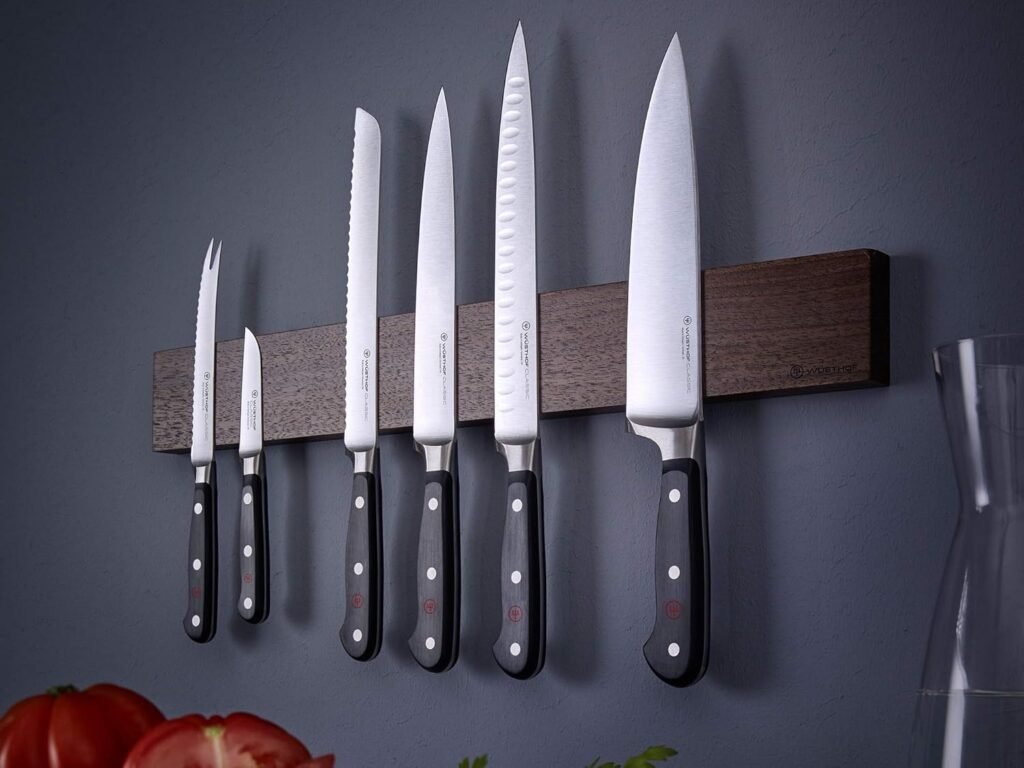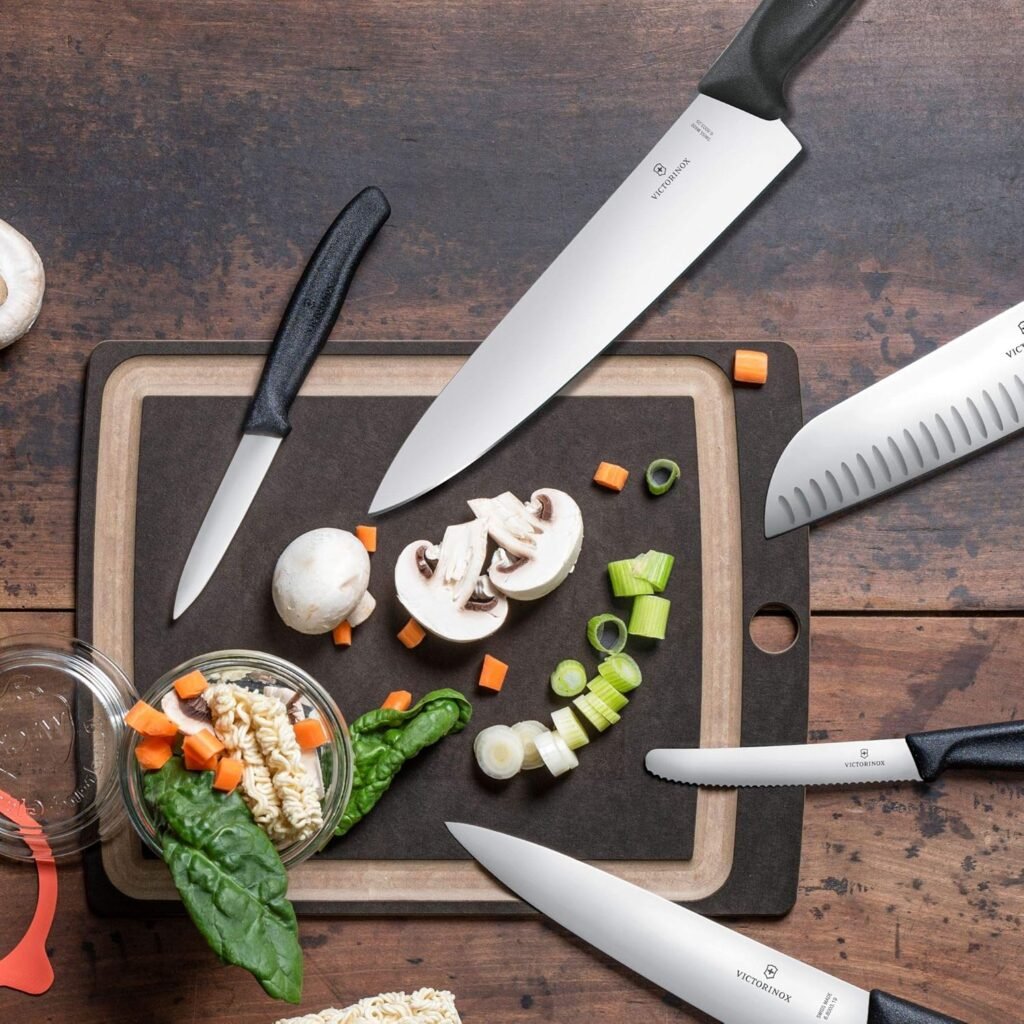
Cooking like a pro starts with the right tools, and at the heart of every chef’s arsenal is a great knife. In this guide, we’ll explore the best chef’s knives on the market, break down the art of keeping them sharp, and share insider tips to help you make the most of these essential kitchen companions.
What Makes a Great Chef’s Knife?
A great chef’s knife is all about balance—both literally and figuratively. It needs to feel comfortable in your hand, stay razor-sharp for various tasks, and be made of durable materials that resist wear and tear. Whether you’re chopping onions, slicing meat, or dicing herbs, the best chef’s knives combine precision, strength, and versatility.
Western-Style vs. Japanese-Style Knives
Western Knives: Sturdy and Versatile
Western-style knives are known for their heavier build and double-beveled edge, providing a robust cutting edge ideal for tougher tasks like cutting through squash or bones.

Japanese Knives: Precision and Lightweight Design
Japanese knives prioritize precision with a single-beveled edge and lighter design. They excel in fine slicing and maintain sharpness longer but require careful handling.
The Best Chef’s Knives by Category
Best Overall Western-Style Knife
The Wüsthof Classic 8-Inch Chef’s Knife reigns supreme for its perfect blend of balance, sharpness, and durability. It’s versatile enough for all kitchen tasks.
Best Budget-Friendly Western Knives
- Mercer Culinary Genesis: Featuring an ergonomic handle and high-carbon stainless steel blade, the Genesis is ideal for home cooks on a budget without compromising quality.
- Mercer Culinary Millennia: A lighter option with a textured grip for added safety, making it a favorite for beginners.
Best Japanese-Style Knife
The Misono UX10 Gyutou is notable for its sleek design, razor-sharp edge, and premium build quality—a must-have for chefs seeking precision.
Best Mid-Range Japanese Knife
The Mac Hollow Edge Chef’s Knife is known for its sharpness and durability; its hollow edge design prevents food from sticking during prep.

Best Budget Japanese Knife
The Misono Molybdenum Gyutou delivers quality craftsmanship at an affordable price, perfect for cooks wanting to explore Japanese knives.
Tips for Choosing the Right Chef’s Knife
- Try Before You Buy: Ensure the knife feels balanced in your hand.
- Consider Blade Length: Most chef’s knives range from 6 to 10 inches; 8 inches is ideal for most cooks.
- Pick the Right Material: Stainless steel is durable and low-maintenance; carbon steel offers superior sharpness but requires more care.
Maintaining and Sharpening Your Knife
Tools for Sharpening
- Whetstones: Ideal for precise sharpening. Find one like the King Whetstone Starter Set.
- Manual Sharpeners: User-friendly for quick touch-ups, such as the Chef’sChoice ProntoPro.
- Electric Sharpeners: Convenient for maintaining edge consistency, such as the Presto EverSharp.
How Often Should You Sharpen Your Knife?
A good rule of thumb is to sharpen your knife every 2-3 months with regular honing in between. Heavy use may require more frequent sharpening.
Understanding Chef’s Knives: A Buyer’s Guide
The Difference Between Japanese and Western Knives
Japanese knives are lightweight with ultra-sharp edges designed for precise cuts. In contrast, Western knives are heavier and robust, suited for power cuts through dense vegetables and thick meats.
Top Picks for Chef’s Knives in 2024
Best All-Around Chef’s Knife
The Global G-2 Chef’s Knife offers a sleek design that’s comfortable and sharp enough for any task.
Budget-Friendly Knives for Home Cooks
The Victorinox Fibrox Pro is a reliable favorite known for its affordability.
High-End Knives for Professionals
For those willing to splurge, the Shun Premier 8-Inch Chef’s Knife delivers unmatched elegance and sharpness.
How to Test a Chef’s Knife Before Buying
Evaluating Sharpness and Edge Retention
Try slicing through paper or thin vegetables; a good knife should cut effortlessly.
Assessing Balance and Ergonomics
Hold the knife while mimicking chopping motions. It should feel stable without strain.
Checking Durability and Construction
Inspect the blade and handle for seamless construction to avoid weak points.
Knife Maintenance Tips for Longevity

Sharpening Techniques for Different Knife Styles
Western knives benefit from honing rods; Japanese knives require finer grit stones.
Proper Storage to Prevent Damage
Use magnetic strips, knife blocks, or blade guards to avoid unnecessary wear.
FAQ: Common Questions About Chef’s Knives
- How Do I Choose the Right Blade Length?
An 8-inch blade works well for most home cooks; smaller blades suit precision work while larger ones are better for heavy-duty tasks. - Are Hybrid Knives a Good Choice?
Yes! Hybrids combine features of both Western and Japanese styles, offering versatility with precision. - What Are the Pros and Cons of Carbon Steel Blades?
Carbon steel is sharper but requires careful maintenance to prevent rust.
Why Sharp Knives Are Essential for Cooking
A sharp knife makes cooking faster and safer while preserving ingredient integrity—ensuring cleaner cuts and better presentation.
Benefits of Regular Knife Maintenance
- Extends lifespan
- Enhances cutting efficiency
- Reduces accident risk from dull edges

In summary, choosing the right chef’s knife involves understanding your cooking style, preferences in design, and maintenance needs. With proper care and regular sharpening, your chef’s knife will remain an invaluable tool in your kitchen arsenal. Investing in quality knives not only enhances your culinary experience but also ensures safety and efficiency while preparing meals. Happy cooking!
